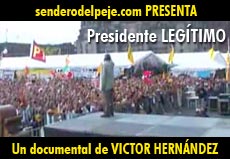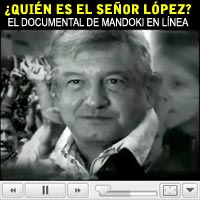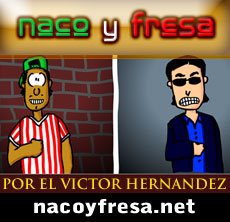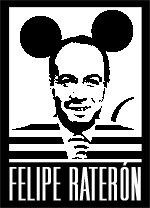Lo hemos estado diciendo desde hace meses: si el país sigue como va, para 2010 habrá una guerra civil en México. Ahora lo confirman analistas internacionales de tendencia de centro en base a la toma de usurpación de fecal y la situación en Oaxaca. Me comenta la lectora que me envió este análisis político:
Esta organizacion, COHA (Conuncil on Hemispheric Affairs o Consejo de Asuntos del Hemisferio), una de las mas importantes en EEUU en materia de relaciones internacionales, con sesgo Centrista, no descarta la revolucion.
El artículo de COHA donde predice la guerra civil está en inglés. Traduzco al final los puntos más importantes:
Friday, December 1st, 2006
Mexico, Reports, Front Page
With Calderón’s Deeply Troubled Inauguration Last Night, Amidst a Deteriorating Security Situation in Oaxaca, the Possibility of a New Mexican Revolution Cannot Be Ruled Out
• The once-localized and relatively contained popular unrest in the southern state of Oaxaca has evolved into the onset of a violent rebellion likely to permanently stain the early days of Calderón’s presidency, and his ability to rule the country effectively
• After being temporarily eclipsed on the national scene, the defeated leftist presidential candidate, Andres Manuel López Obrador, is making his high risk feint of trying to capitalize on Oaxaca’s chaos to boost his own “revolution” by launching a “parallel government”
• The ongoing protests in Oaxaca have put an intense strain on Calderón, and will challenge his capacity to govern a country stymied by mounting volatility in Oaxaca as well as in the Mexican Congress
On the morning of November 6, radical protesters in support of the Oaxaca popular movement detonated bombs at three high-profile targets in Mexico City, including the PRI headquarters and the Federal Electoral Tribunal. Although the attacks caused no injuries, the upsurge of violence demonstrates the escalating scope of unrest which was once confined to the main square of the southern city of Oaxaca. Elsewhere in the country, the intensity of the violence reached a fever-pitched climax with the Ixtapa resort attacks in the state of Guerrero when, on November 7, bombers openly targeted the then incoming President, Felipe Calderón and his predecessor, Vicente Fox. Yesterday, Mexico City was the setting for the unrest when a near riot took place in the Mexican Congress, temporarily preventing Calderón from entering the institution.
The Oaxaca crisis originally started out as a peaceful, state-wide teachers’ strike last May, which rapidly drew allies from civil society organizations, indigenous communities and leftist activists. Within the past few months, however, this ad hoc coalition has morphed into a roiling mass movement which, like a line of fire, quickly spiraled out of control after the more radical wing of its supporters started to use the movement’s banner to cloak their own agenda.
At its inception, nobody could have predicted that the teachers demand for a wage hike would grow into a full-blown revolt against the notoriously corrupt Oaxaca governor, Ulises Ruiz, a high-level PRI functionary and the prime target of the unrest. The now six-month-old quasi-insurrection can be partly ascribed to the deep-seated venality that continues to flourish in several of Mexico’s poorest states, despite the recent wave of democratization initiated in 2000. The protests also reflect a feeling of near-desperation among a disillusioned and radicalized working class which has yet to see significant improvements in its living standards and has been fully swayed by López Obrador’s populist orations. Now that the movement has taken a dramatic turn, reaching new levels of nationwide violence, it looks as though President Calderón has inherited a complex political crisis that threatens the success of his presidential term and, in a doomsday scenario, could even translate into a civil war. Aside from the disaster that such a denouement would have for Mexico, it could produce a new round of seismic explosions along the U.S. border, as hundreds of thousands of Mexicans try to escape a new round of violence and upheaval.
A Long History of Impunity: PRI’s Old Habits Die Hard
The current national emergency that is now casting a very large shadow extending beyond the state of Oaxaca has its roots in the institutionalized oppression and entrenched flaws of the once-ruling Institutional Revolutionary Party (PRI), an oligarchic group which dominated Mexico’s political life for over seven decades. The party was originally comprised of a loose confederation of local political caudillos and military strongmen, grouped together with self-serving and machine-driven labor unions and peasant organizations. Throughout its reign, the PRI successfully contained political competition among the leaders of the party’s various factions and sectors, using a platform that was revolutionary in its rhetoric but hegemonic in its policies. It ruled by means of a complex corporatist system and through authoritarian methods until Vicente Fox of the center-right National Action Party (PAN) captured the presidency in 2000, and soon exhibited his own special inability to rule the country effectively.
Even though the PRI began to lose dominance over the Mexican political scene in the late 1980s, the country’s 2006 electoral showing indicated that the party was still an ominous force on the political stage, due to its capture of an impressive number of congressional seats which would enable it to be the spoiler in the legislature. More importantly, the PRI has been able to retain control and perpetuate the trapping of one-party rule in some poor southern states, in part by handing out jobs and goods just prior to the elections. While effectively hampering the consolidation of the rule of law, its clientelist practices allowed Governor Ruiz to continue to sit on his troubled throne. As a member of the old-line conservative branch of the PRI (the “dinosaur”), he has ruled despotically since being charged with rigging the 2004 state election, where he combined political cooptation with a high-threshold for tolerating blatant corruption.
For many years, Oaxaca citizens have been dominated by a police force which has never been held responsible for its repeated abuse of authority. More recently, local authorities have resorted to sustained intimidation tactics to drive their opponents into a fear-induced silence. Ruiz has also been accused of encouraging the creation of paramilitary groups to quell dissidents. Last June, demonstrators denounced the presence of “irregular armed groups” in the municipality which were presumed at the time to be state police dressed in civilian clothing. These “grupos de choque” (death squads) participated in a series of repressive acts commissioned by Ruiz. One of the most well-known victims of this police brutality was the social activist Germán Mendoza, a wheelchair-bound educator. Arrested on August 9, Mendoza was mercilessly beaten and falsely charged with murder before finally being acquitted.
An Atypically Peaceful Revolt
Since the 1980s, the teacher’s union, represented by the Sindicato Nacional de Trabajadores de la Educación (SNTE), has staged a convention in May to coordinate demands for higher wages, improved worker conditions and additional funds for schools in the more rural parts of the state. This year, as the teachers’ pleas once again went unheeded- if ever seriously examined by the indifferent Secretary of State Secretary Jorge Franco Vargas – a major strike broke out on May 22, essentially coordinated by Section 22, a unit of the SNTE.
On June 14, Oaxaca’s state police, armed with tear gas and automatic weapons, launched a pre-dawn raid in order to evict the demonstrators and level their street camps. This turn of events led to an unprecedented mustering of all sectors of civil society in a vast manifestation against the repressive policies of the Oaxaca governor. In all, the mobilization combined 70,000 public school teachers and 350 organizations, which rapidly united to form the Popular Assembly of the People of Oaxaca (Asamblea Popular de los Pueblos de Oaxaca - APPO). The coalition occupied the center of the city, blocked the state’s executive, judicial and legislative buildings, erected barricades throughout the central areas of the city and organized several marches in which upwards of 800,000 people participated.
In an attempt to provide a vehicle for the expression of APPO’s perspective, protesters seized radio frequencies such as La Ley, a private radio station, as well as TV channels. APPO soon linked up with other local organizations with deep historical roots to rally behind the teachers in demanding long-term changes that would bring them closer to achieving democratic rule in Oaxaca. Therefore, the coalition’s goals go well beyond the ousting of Governor Ruiz. APPO also pledges to build a national, non-violent, anti-capitalist movement capable of creating a genuine democracy in which the average citizen actually participates.
The PAN’s “Dangerous Liaisons”
Although Mexico’s central government does not have the plenary power to remove a governor from office, the Senate can initiate impeachment proceedings. However, under Mexican law, it is extremely difficult to impeach a governor. For that to happen, Congress would have to decide that none of the three branches (legislative, judicial and executive) of a particular state government function effectively. APPO’s hopes of witnessing Ruiz step down seemingly evaporated on October 18, when the Senate decided that there was no evidence of a power vacuum in Oaxaca that would justify the nomination of an interim governor. Immediately thereafter, what can be seen as an informal alliance between the PAN and the PRI sprung up from then-incoming President Calderón’s awareness of the necessity to forge a compromise with the PRI, his new key “ally,” in order to strengthen his presidential mandate. This involvement with a discarded PRI has prevented him from assuming a firm stand against Ruiz, as the PRI is still a potentially valuable colleague with the third largest number of congressional seats (103). Top party officials have been quick to warn Calderón that any overt hostility to Ruiz would jeopardize his presidency. Deputies from the Partido Acción Nacional (PAN) and the Partido de la Revolución Democrática (PRD) stayed overnight on November 28 and 29 to prevent each other from seizing control of the podium in Congress. President Calderón took an oath of office just after midnight on November 30 at the presidential palace, Los Pinos.
Fox’s Reluctant Move
In Oaxaca, since the inception of the anti-Ruiz movement, demonstrators have been calling for the federal government to initiate a mediation process. However, feeling the same constraints that now plague Calderón, President Fox had long refused to directly intervene. He did eventually step in when the death of American journalist Bradley Roland Will in Oaxaca made headlines worldwide. On October 29, Fox sent 4,500 Federal Preventative Police (PFP) officers into Oaxaca in order to retake the city and push back thousands of dissidents from the main square.
Faced with unrelenting resistance and mounting violence, Congress overrode the Senate’s binding limitations and finally voted on October 31 for the “immediate departure of Ulises Ruiz,” contradicting the previous Senate ruling and prompting even more confusion. Federal legislators have also passed an ouster resolution with the support of Ruiz’s own party, the PRI. This reversal can be partly ascribed to the widening circle of Ruiz’s critics, who have suggested that his resignation would benefit the country.
In addition, a report released on November 16 by the Senate Human Rights Commission revealed that the ongoing conflict in Oaxaca has been marked by murders, detentions, and disappearances, along with other derelictions. The document also found that there was enough evidence to impeach Ruiz and other local officials for their involvement in 98 political abductions, 93 arrests, 15 questionable deaths and numerous incidents of torture by the Federal police, among others, which tended to corroborate complaints made by the APPO. However, in spite of the increasing heat, the federal government has, thus far, failed to remove Ruiz, whose determination to remain in office has been confirmed by his adamant public pledge to serve out his term which ends in 2010.
A Radicalization of Violence and its Implication
The interposition of the Federal Police in Oaxaca was rancorously received by anti-Ruiz activists, and contributed to the further radicalization of the struggle. The situation prevailing in the city is increasingly anarchic. The APPO’s assembly is in reality far from homogeneous, and aspires to gather an even broader membership of diverse social organizations, political groupings, unions, and human rights organizations, often with distinct political perspectives, agendas and visions. As a result, some manifestations of solidarity with Oaxaca’s protesters have already occurred in the southern states of Michoacán and Chiapas in early November.
Thousands of indigenous residents of Chiapas – who provide a civilian support base for the Zapatista Army of National Liberation (EZLN) – have made plans to block all major roads and highways in the state in order to prepare for the defense of their counterparts in neighboring Oaxaca. However, some groups decided to respond to the prevailing violence in kind, which has threatened to undermine the credibility of APPO. A recent example of this occurred on November 20, when masked protesters joined the fray and, armed with sticks and rocks, clashed with police. This act of violence has consistently been condemned by APPO and has been seen as an unwelcomed by-product of Oaxaca’s ongoing revolt. Further complicating APPO’s desire to conduct a peaceful movement is the new guerilla group, Tendencia Revolucionaria-Ejercito del Pueblo, which has recently announced the launching of a campaign to unify the country’s revolutionary left into a homogenized movement. The faction decided to create the Asamblea Popular de los Pueblos de Mexico (APPM), and offered to work with the EZLN, known for its 1994 revolution in the state of Chiapas, and López Obrador’s National Democratic Convention.
López Obrador, of the PRD, has seen the growing public unrest as an opportunity to win over Oaxaca’s angry activists and possibly utilize the recent abuse against them in his campaign for a parallel government. Instead of denouncing Mexico’s escalating violence, the PRD has expressed its support for the protests, in exchange for APPO’s potential backing of the party’s elected officials. However, his strategy to press the demands of an impoverished underclass whose long-simmering rage has finally boiled over is risky, and could prove “destructive,” according to journalist Sergio Sarmiento of Reforma. López Obrador’s attempt to extract political dividends from Oaxaca’s rebellion is likely to fall short as polls recently suggested that 56 percent of Mexicans disapprove of his declaration that he was the country’s “legitimate president,” even though he has good reason to challenge certain aspects of the campaign and the vote count.
A Necessary Revolution?
Amidst an increasingly polarized environment, APPO has steadfastly promoted the importance of dialogue and, in mid-November, repeated its intention to convert its popular revolt into a peaceful, democratic and humanist revolution, using as its model the indigenous communities of Chiapas. This appears reminiscent of the Zapatista’s “Other Campaign,” which tried to combine an innovative strategy of local autonomy with an ongoing reinvention of participative democracy in order to change the status quo.
Although some observers have claimed that the situation in Oaxaca is highly illustrative of Mexico’s dysfunctional democracy, they do not see that the APPO may better signify the emergence of an increasingly sophisticated citizenry. This citizenry is capable of making articulate and rational demands on the system, and although its legitimacy may have been dented by the gratuitous violence of its radical wing, its mission remains formidable. An embryonic yet forceful voice is emerging in Mexico, and with it an assertive, autonomous vision of a civil society capable of monitoring and criticizing the performance of the authorities. The APPO is eager to play a constructive role in policymaking and set the tone for future acts of dissent. In itself, Oaxaca’s movement represents a “people’s revolution” which, if allowed to run its course, could point the way for a deep reform of the Mexican State.
Calderón’s Labyrinth of Solitude
The resignation of Ruiz may not necessarily be a cure for the nation’s maledictions. Even though his departure is the obvious precondition to resume negotiations with the teachers union and the APPO, it is unlikely that Calderón will have a hand in forcing Ruiz to step down. Already, Calderón must deal with two pressing issues – achieving a regional, if not nationwide peace and resolving the bitter dispute over the status of Ruiz – which, if neglected, will certainly prevent, or at least hinder, the implementation of his platform. In a pragmatic and reconciliatory way, he has called on all citizens to transform Mexico into a country of laws and promised he will seek the political center, fully aware of the necessity of integrating the poor into his political agenda. Calderón knows that unless he reaches out to the people at the bottom of the economic ladder, his presidency will likely founder. For this reason, he has pledged to maintain and expand large-scale poverty programs such as “Oportunidades,” which has been effective in eradicating deeply entrenched poverty in affected rural areas.
Mexico’s new president has also offered to implement a “common agenda.” The idea – relatively alien for a country like Mexico – comes from his extensive experience in Congress. Unlike his predecessor, Calderón knows that negotiation is now more than ever the key for successful reforms in Congress. However, such reforms will be dependent upon his capacity to shape political alliances, in which the PRI’s vote will be necessary but still not enough to initiate structural changes proposed by the PAN. One of his major challenges will be to bring accountability and openness to the political process at all levels, which will include punishing regional barons who have continued to undermine any progress towards the democratization of Mexico’s basic institutions.
This analysis was prepared by COHA Research Associate Magali Devic
December 1st, 2006
Esencialmente el análisis basa su temor de una guerra civil en la incapacidad de fecal para tumbar a Ulises Ruiz. El conflicto de Oaxaca se desbordado ya a otros estados y la izquierda--que representa 15 millones de mexicanos que votaron en estas elecciones--lo apoya. Pero como fecal tiene amarradas las manos, no hay manera de que el conflicto se resuelva, lo cual sería el detonante para una insurrección en todo el país en el momento en el que la desigualdad y la pobreza empiece a asfixiar a los 50 millones de pobres en el país--y más ahora que se ha instalado el muro fronterizo.
Y si creen que es cuento esto de que el conflicto de Oaxaca ya se desbordó a otros estados, vean esta nota del Universal:
Viajarán a Nayarit familiares de detenidos en Oaxaca
Buscan corroborar el estado de salud en que se encuentran y apelar el auto de formal prisión que les fue girado
Familiares de los 141 detenidos durante el enfrentamiento registrado aquí el pasado 25 de noviembre, viajarán esta tarde al estado de Nayarit para corroborar el estado de salud en que se encuentran y apelar el auto de formal prisión que les fue girado.
Entre los detenidos se encuentra el presidente municipal de San Juan Yaeé Villa Alta, Javier Sosa Martínez, quien fue detenido incidentalmente, sin que estuviera involucrado en las movilizaciones.
El asesor jurídico de los familiares de presos y desparecidos, Casiano Luis Mejía, enfatizó que se trata de un proceso “amañado”, pues los abogados tienen acceso a los expedientes; no tienen copias de las averiguaciones, mientras que los defensores de oficio nunca quisieron intervenir.
En la comitiva que partirá esta tarde al estado de Nayarit acudirán aproximadamente 100 personas y un autobús que fue pagado con la ayuda de la ciudadanía.
Aun así, Luis Mejía advirtió que el estado de indefensión de los detenidos es total. La comitiva llegara a Nayarit este lunes por la mañana.
El abogado precisó que cuentan con el apoyo de representantes de Amnistía Internacional, así como de la Liga Mexicana de Defensa de los Derechos Humanos, que encabeza Jessica Sánchez Maya.
Aun así, denunció, el penal de Nayarit se ha sumado a la campaña de represión contra simpatizantes de la APPO pues a los familiares les piden requisitos extremos para acudir a las visitas, tal como su acta de nacimiento, mientras que a los abogados les solicitan copia de su cedula profesional.
¿Cómo es posible que hayan detenido hasta a un presidente municipal SIN QUE HAYA TENIDO NADA QUE VER y que de pilón lo manden a Nayarit por considerarlo "de alta peligrosidad"?
Es precisamente ese tipo de represión la que va a desatar la guerra civil en México. Fecal se caga de miedo todos los días y cree que rodeándose de gorilas ya se acabaron los problemas del país. Lo único que logró fue hacer más grande el problema.
Una razón más para apoyar al peje en el 2006.








 Click aquí para ir a la audioteca
Click aquí para ir a la audioteca Click aquí para ver el documental de El Sendero del Peje
Click aquí para ver el documental de El Sendero del Peje


 Click en la imagen para ir al almacén de archivos.
Click en la imagen para ir al almacén de archivos. Click en la imagen para leer
Click en la imagen para leer
 www.elchamucovirtual.blogspot.com
www.elchamucovirtual.blogspot.com


















No hay comentarios.:
Publicar un comentario